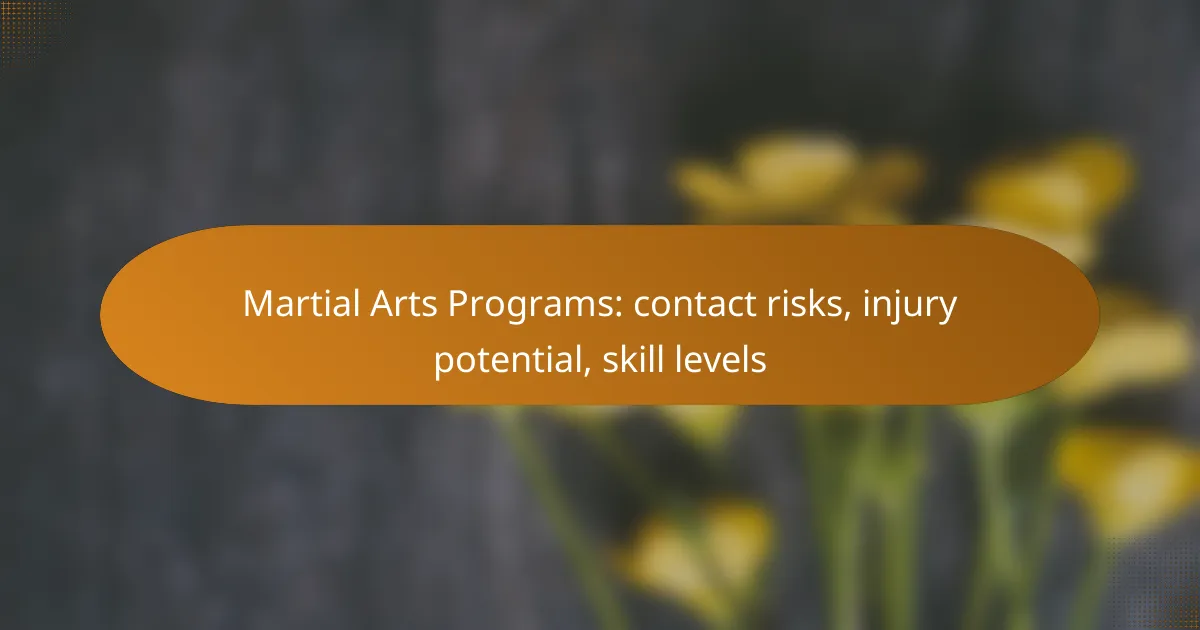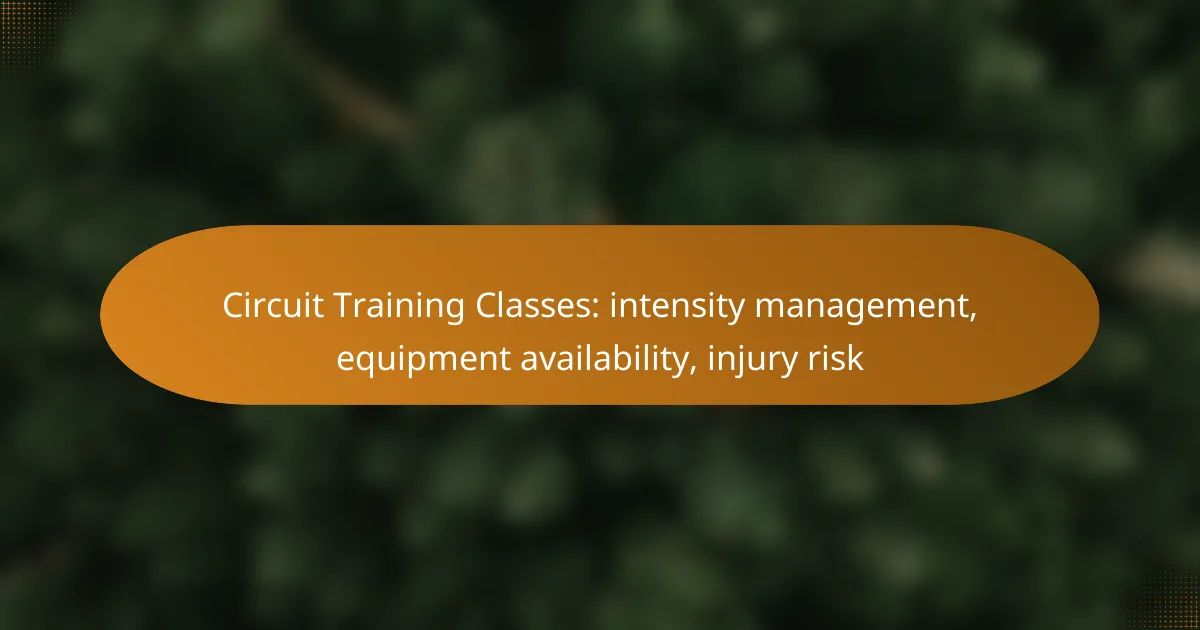Martial arts programs present unique contact risks that can lead to physical injuries during both training and competition. To mitigate these risks, it is essential for participants to utilize proper protective gear, engage in supervised training, and adhere to safe sparring practices. Additionally, these programs accommodate various skill levels, from beginners to advanced practitioners, allowing for a structured and progressive training experience tailored to individual abilities and goals.

What are the contact risks in martial arts programs?
Contact risks in martial arts programs primarily involve physical injuries that can occur during training and competition. Understanding these risks is crucial for participants to take appropriate precautions and minimize injury potential.
Physical injuries from sparring
Sparring involves controlled fighting between practitioners, which can lead to various physical injuries. Common injuries include bruises, sprains, and strains, often resulting from direct contact or improper technique. To reduce these risks, participants should wear appropriate protective gear, such as headgear, mouthguards, and padded gloves.
Practitioners should also engage in proper warm-up routines and focus on technique to avoid unnecessary injuries. Regular communication with training partners about intensity levels can help maintain safety during sparring sessions.
Injury from falls and throws
Falls and throws are integral to many martial arts, but they carry a risk of injury if not executed correctly. Participants may experience sprains, fractures, or concussions from improper landings. It is essential to learn proper falling techniques, such as rolling or breaking falls, to minimize impact and injury.
Training on softer surfaces, like mats, can also help cushion falls. Instructors should emphasize safety and technique when teaching throws to ensure students understand how to protect themselves during practice.
Potential for head trauma
Head trauma is a significant concern in martial arts due to the potential for strikes to the head during sparring or competition. Concussions and other brain injuries can occur, making it vital for participants to recognize the signs of head trauma. Symptoms may include dizziness, confusion, or headaches.
To mitigate these risks, practitioners should use headgear during sparring and adhere to strict rules regarding strikes to the head. Regular medical check-ups and awareness of concussion protocols are also recommended to ensure the safety of all participants.
Skin abrasions and infections
Skin abrasions can occur during training due to friction with the mat or contact with opponents, leading to cuts and scrapes. These injuries can become infected if not properly treated. It is crucial for martial artists to maintain good hygiene and promptly clean any wounds.
Using protective gear, such as rash guards or long sleeves, can help reduce the risk of abrasions. Additionally, participants should be aware of the signs of infection, like redness or swelling, and seek medical attention if necessary to prevent complications.

How can injury potential be minimized in martial arts?
Injury potential in martial arts can be minimized through a combination of proper protective gear, supervised training, regular health screenings, and safe sparring practices. Implementing these strategies helps create a safer environment for practitioners of all skill levels.
Proper protective gear usage
Wearing appropriate protective gear is essential in reducing injury risks during martial arts training and competitions. Common gear includes headgear, mouthguards, shin guards, and padded gloves, which can absorb impact and prevent injuries.
Instructors should ensure that all students are equipped with the necessary protective equipment before engaging in any sparring or contact drills. Regularly checking the condition of the gear is also crucial, as worn-out equipment may not provide adequate protection.
Supervised training environments
Training under the supervision of qualified instructors significantly lowers the risk of injuries. Instructors can provide immediate feedback, correct techniques, and intervene in potentially dangerous situations.
Establishing a structured training environment with clear rules and guidelines helps maintain safety. Ensuring that classes are appropriately sized allows instructors to give adequate attention to each student, further enhancing safety during practice.
Regular health screenings
Conducting regular health screenings for martial arts practitioners helps identify any pre-existing conditions that could increase injury risk. Screenings can include assessments of physical fitness, flexibility, and any previous injuries that may require special attention.
Encouraging students to report any health issues or concerns to their instructors fosters a culture of safety. This proactive approach allows for tailored training modifications that can help prevent injuries.
Safe sparring practices
Implementing safe sparring practices is vital for minimizing injury potential. This includes setting clear rules about contact levels, such as light contact for beginners and controlled sparring for advanced practitioners.
Using controlled environments, such as padded mats and designated sparring areas, can further enhance safety. Instructors should regularly monitor sparring sessions to ensure that all participants are adhering to safety guidelines and adjusting their intensity as needed.

What skill levels are available in martial arts programs?
Martial arts programs typically offer a range of skill levels, including beginner, intermediate, and advanced classes. Each level is designed to cater to students’ varying abilities and goals, ensuring a structured progression in their training.
Beginner classes for new students
Beginner classes are specifically tailored for individuals who are new to martial arts. These sessions focus on foundational techniques, basic movements, and essential safety practices, providing a solid introduction to the discipline.
Students can expect to learn simple stances, basic strikes, and fundamental self-defense techniques. The environment is usually supportive, allowing newcomers to build confidence and develop their skills at a comfortable pace.
Intermediate training for skill development
Intermediate training is designed for students who have mastered the basics and are ready to enhance their skills. This level often introduces more complex techniques, combinations, and sparring practices.
Participants may work on improving their speed, power, and precision, as well as learning to apply techniques in various scenarios. Classes may also include drills that focus on strategy and timing, preparing students for more advanced challenges.
Advanced programs for competition preparation
Advanced programs cater to experienced martial artists who are preparing for competitions or seeking to refine their skills further. These classes emphasize high-level techniques, advanced sparring, and tactical strategies.
Students often engage in rigorous training sessions that include conditioning, mental preparation, and competition simulations. This level is ideal for those aiming to compete at local, national, or international events.
Specialized classes for specific techniques
Specialized classes focus on particular techniques or styles within martial arts, such as grappling, striking, or weapon training. These classes allow students to delve deeper into specific areas of interest and enhance their overall skill set.
Participants can choose classes based on their goals, whether it’s improving their ground game in Brazilian Jiu-Jitsu or mastering forms in traditional Karate. These targeted sessions provide an opportunity for focused learning and skill refinement.

What are the prerequisites for joining martial arts programs?
Prerequisites for joining martial arts programs typically include age restrictions, physical fitness assessments, and background checks, especially for competitive classes. Understanding these requirements helps ensure that participants are adequately prepared and safe while training.
Age requirements for different classes
Age requirements vary significantly among martial arts programs, often depending on the style and the school’s policies. Many programs offer classes for children as young as 4 or 5 years old, while others may have minimum age limits of 8 to 12 years for more advanced training.
For adult classes, there is generally no upper age limit, but some schools may recommend certain age ranges for specific programs. It’s essential to check with local schools to understand their specific age policies and class structures.
Physical fitness assessments
Many martial arts schools conduct physical fitness assessments to determine a student’s readiness for training. These assessments often evaluate strength, flexibility, endurance, and coordination, ensuring participants can safely engage in the physical demands of martial arts.
Some programs may require a basic fitness level, while others might offer introductory classes designed for beginners. It’s advisable to consult with instructors about any fitness prerequisites before enrolling.
Background checks for competitive programs
Background checks are commonly required for participants in competitive martial arts programs, particularly for minors. These checks help ensure a safe environment by screening for any potential risks associated with coaching or training.
Schools may require parental consent for background checks on minors and may also have specific policies regarding the handling of sensitive information. Always inquire about these procedures when considering a competitive program for yourself or your child.



